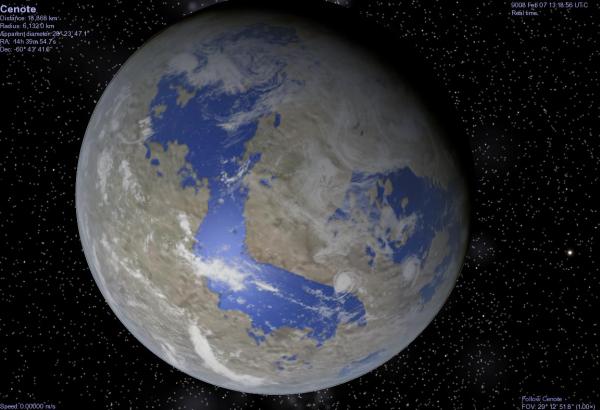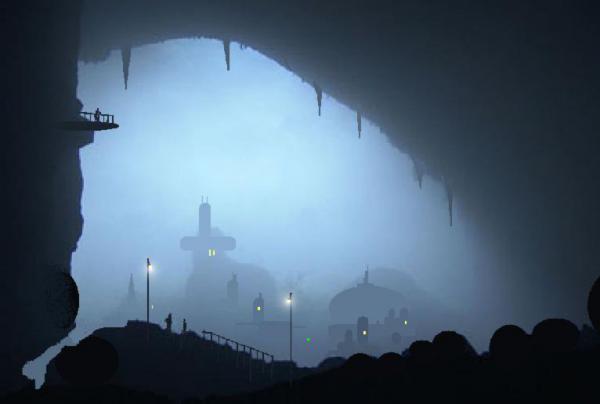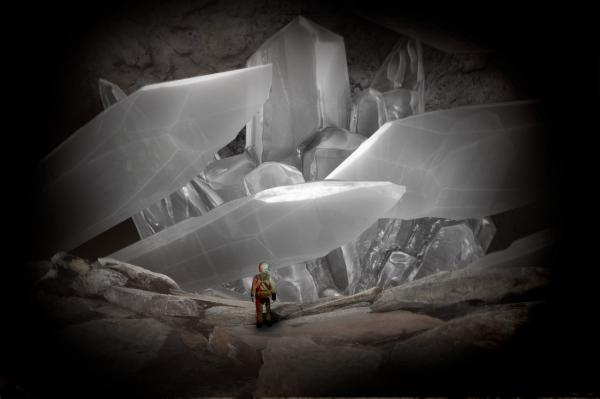BY LETTER
Cenote
Galactography > Regions of Space > Outer Volumes
Galactography > Sephirotic Empires > Solar Dominion
Galactography > Systems and Worlds > Systems & Worlds C - D
Galactography > Sephirotic Empires > Solar Dominion
Galactography > Systems and Worlds > Systems & Worlds C - D
The Deep Caves and the Hypogean Clade | |
 Image from Steve Bowers | |
| This postgaian world has a carbon-rich crust, extensive limestone karst landscapes and cave systems | |
Cenote - Data Panel | |
| System | Cenote |
|---|---|
| Star | YTS 233-091-0998 3075 ly from Sol |
| Constellation | Cameleopardis |
| Class | G5V |
| Luminosity | 1.2 x Sol |
| Age | 6.4 GY |
| Planet | Cenote |
| Nolwocs classification | Postgaian, terraformed to Campian Subtype |
| Diameter | 10,908 km |
| Gravity | 0.94 gee |
| Semimajor Axis | 0.9 AU |
| Year Length | 0.95 standard years |
| Day Length | 31.8 hours |
| Tilt | 15 degrees |
| Allegiance | Solar Dominion |
After this period, tectonic activity declined and eventually ceased almost completely, as a result the carbon dioxide level in the atmosphere fell too low to support photosynthesis. The ecology of the planet collapsed when the phytocoral died back, and the world was almost lifeless when the first explorers arrived from the Solar Dominion.
Despite having a minimal biosphere, the atmosphere had a respectable oxygen component of 10%. Over time this would be absorbed by the crust, leaving only nitrogen and argon. Salty seas covered just under a third of the planet, but the atmosphere held enough water vapour to allow rainfall. Some of this precipitation remained on the planetary surface, forming lakes and wide rivers; but much of the water found its way underground into the innumerable limestone cave systems in the extensive karst landscapes.
The Solar Dominion long distance linelayer Yucatan arrived in 7107 with a micro wormhole and a small cargo of digitised colonists, who were to be given new bodies on arrival. The planet was given the name Cenote, in reference to a much smaller cave system described in records of Old Earth. The pioneers were fascinated by the cave system and most requested that they be incarnated as water breathing humans so that they could dedicate themselves to exploring and mapping the underground world of the caves. Only a few remained on the surface, working to increase the oxygen level and constructing small cities carved into the karst for the next wave of colonists who would arrive once the wormhole opened.
Tens of thousands of cubic kilometres of cave were surveyed, much of it by the explorers themselves, but large parts of the underground world remained inaccessible. The Cenoteans developed a number of different exploration probes which could be operated remotely in restricted spaces, including microscopic threadbots which could enter minute fissures. With such devices they discovered many large and deep caverns, often filled with the salt water of the oceans with a layer of fresh water on top separated by a distinct halocline.
 Image from Steve Bowers | |
| Gaping Ghyll City is located in the mouth of a collapsed cave structure near the equator | |
Some of the caves were so difficult to gain access to that they were known only to a few; in time these secret caves became home to a society of Hiders, the Hypogeans, who used geothermal energy and mined hydrocarbons to survive without interacting with the outside world. These hiders remained undetected for nearly a thousand years, although they were the source of many legends and tales. Often a fleet of threadbots would be dispatched to search for the truth behind the legends, but the Hypogeans used a number of largely autonomous counter-surveillance mechanisms to deactivate these devices. When a curious transapient Dominion Luminary from the local Prefecture joined the search, and employed microscopic explorer devices resembling oolite grains, these defences were finally breached, and contact was made with the isolated society within this labyrinthine world.
More recently the Hypogeans have largely departed to join other hider clans in the outskirts of various nearby systems; but some few remain, either as willing hosts to curious and adventurous tourists, or (it is rumoured) delving ever deeper into the bedrock of the planet.
In the Current Era the world of Cenote has extensive Reef-cities lining the shores of the shallow oceans.
 Image from Steve Bowers | |
| The giant calcite crystals in Spukil Cave are among the largest in the Terragen Sphere | |
Related Articles
- Coral - Text by M. Alan Kazlev and Stephen Inniss
Terragen marine metazoan animals, class Anthozoa, phylum Cnidaria. Though some are solitary, a typical coral is a colony of genetically identical polyps, each of which secretes calcium carbonate at its base to create a common skeleton with a characteristic structure. They are often brightly colored when alive, but after death of the polyp the color fades and becomes a bleached white. The best known and most numerous types of corals derive much of their sustenance from symbiotic photosynthetic algae. Because of this these are limited to regions of sunny shallow water and low nutrient flow, where bright light reaches the ocean floor. Such corals are an important element of many phototrophic tropical ocean biospheres. - Coral Reef - Text by M. Alan Kazlev
Aquatic Terragen community of organisms, wave-resistant biological structure resulting from cementation processes and the skeletal construction of hermatypic corals, calcareous algae, and other calcium carbonate-secreting organisms. Forms a rich habitat for many types of marine organisms. Coral reefs are popular in many large Terragen habitats with a strong aquatic component and tropical or semi-tropical climate. Some coral reefs have been provolved to sapience. - Reef, Reef-city
Appears in Topics
Development Notes
Text by Steve Bowers
Initially published on 16 April 2008.
Initially published on 16 April 2008.
Additional Information
Cenote - Celestia Information | |
| Download | Simply download Cenote.Zip into your extras file in Celestia, (note: this will replace some pre-existing files in the OA Addons file if you already have downloaded other Orion's Arm addons). ------------------------ You can then visit YTS 233-091-0998 to find Cenote. Or you can visit this CelestiaURL: Cenote . Note that this URL will only work when both Celestia and the Cenote Add-on are installed. |
|---|---|
| Bonus planets | If you have downloaded the other OA Addons packages, particularly packages One, Two (warning; large file) and Three, then you can visit some new planets in systems nearby to Cenote. You can find these stars using the Nearby Stars function in Celestia, or by visiting these CEL:urls. Sequence (an eujovian in the Cenote system) YTS 233-091-0997 b (a ringed eujovian world) YTS 233-091-0997 c (an areanxeric world) YTS 233-091-0997 d (an areanxeric world) YTS 233-091-0102 b (a eujovian world) YTS 233-091-0102 c (a cryojovian world) YTS 233-091-0991 b (an epistellarjovian world) YTS 233-091-0991 c (a hydrojovian world) YTS 233-091-0992 b (a pyrothallassic world) YTS 233-091-0992 c (a ymirian world) YTS 233-091-0101 c (an arean type world) Note that most of these planets are currently un-named and uncolonised; feel free to name and colonise them or their moons |
| An add-on for the Celestia Space Visualisation program | |






